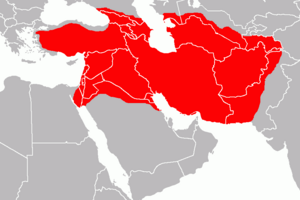Ninus facts for kids
Ninus was a legendary king from ancient times. Greek historians wrote about him, saying he founded the city of Nineveh, which was a very important capital in ancient Assyria. It's not clear who Ninus might have been in real Assyrian history, but some people think he might be connected to a god named Ninurta or a king named Shamshi-Adad I or Shamshi-Adad V.
Contents
Stories About Ninus
Many old stories give Ninus credit for important firsts. For example, he was said to be the first to train hunting dogs. He also taught people how to tame horses for riding. Because of this, some Greek myths even show him as a centaur, which is a creature that is half-human and half-horse.
The stories of King Ninus and Queen Semiramis first appeared in a history book written by a Greek doctor named Ctesias of Cnidus around 400 BC. He said he had access to royal records. Later, another historian named Diodorus Siculus added more details to Ctesias's stories. European historians continued to mention Ninus for a long time. However, once people learned to read ancient writings called cuneiform in the 1800s, they could learn more accurate history from Assyria and Babylonia.
Ninus was said to be the son of a figure named Belus or Bel. This name might have been a title like "lord." According to one historian, Ninus ruled for 52 years, starting around 2189 BC. He was believed to have conquered all of western Asia in just 17 years. He did this with help from Ariaeus, the king of Arabia. He defeated kings like Barzanes of Armenia and Pharnus of Media.

The stories say that after conquering many lands, Ninus went to war against Oxyartes, the king of Bactriana. He had a huge army of nearly two million soldiers. He captured all of Bactriana except its capital city, Bactra. While he was attacking Bactra, he met Semiramis. She was the wife of one of his officers. Ninus took her as his own wife. They had a son named Ninyas, who was said to become king after Ninus.
Some stories also claim that after Ninus died, his wife Semiramis built a huge tomb for him near Babylon. This tomb was said to be very tall and wide. Later, the famous love story of Pyramus and Thisbe was set near this tomb. Semiramis was also said to have fought against the last independent king in Asia, King Stabrobates of India. However, she was defeated and injured. After this, she gave up her power to her son Ninyas.
Who Was Ninus Really?
Some historians from ancient Rome thought that Ninus's enemy, the king of Bactria, was actually Zoroaster, a famous prophet.
In some old Christian writings, Ninus was connected to the biblical figure Nimrod. The author of these writings said Nimrod taught the Persians to worship fire. In the Book of Genesis in the Bible, Nimrod is sometimes said to have founded Nineveh. However, other translations say that Ashur founded Nineveh.
More recently, in the 1800s, a writer named Alexander Hislop connected Nimrod with Ninus in his book The Two Babylons.
Is Ninus a Real Historical Figure?
Today, experts who study ancient Mesopotamia, called Assyriologists, have learned a lot from reading many ancient clay tablets with cuneiform writing. This has helped them understand the true history of places like Sumer, Akkad, Babylonia, and Assyria.
Ninus is not mentioned in any of the long lists of kings that the Mesopotamians themselves wrote down. He also doesn't appear in any Mesopotamian stories. It's possible that the Greek stories about Ninus were inspired by the actions of one or more real Assyrian kings, or by Assyrian myths.
Similarly, the biblical character of Nimrod is not found in any Assyrian, Babylonian, or Sumerian writings. However, many scholars believe Nimrod might have been inspired by a real king. One possibility is Tukulti-Ninurta I, an Assyrian king from the 13th century BC, or even the Assyrian war god Ninurta.
There was a real Assyrian queen named Shammuramat. She ruled the Neo-Assyrian Empire for five years starting in 811 BC as a regent for her son Adad-nirari III. She was the wife of King Shamshi-Adad V. Some people think the later Greek myths about Semiramis were inspired by the unusual fact that a woman ruled such a powerful empire.
Ninus in Culture
The story of Pyramus and Thisbe is featured in William Shakespeare's play A Midsummer Night's Dream. In the play, a group of actors performs this story. They often mispronounce "Ninus' Tomb" as "Ninny's Tomb."
The story of Ninus and Semiramis also appears in a different form in an ancient Greek romance novel from the 1st century AD. This book is sometimes called the Ninus Romance.
In his book Etymologiae, a scholar named Isidore of Seville claimed that Ninus was the one who invented idolatry. He said Ninus made a gold statue of his father, Belus, and worshipped it. This idea was very influential throughout the Middle Ages.
See also
 In Spanish: Nino para niños
In Spanish: Nino para niños

